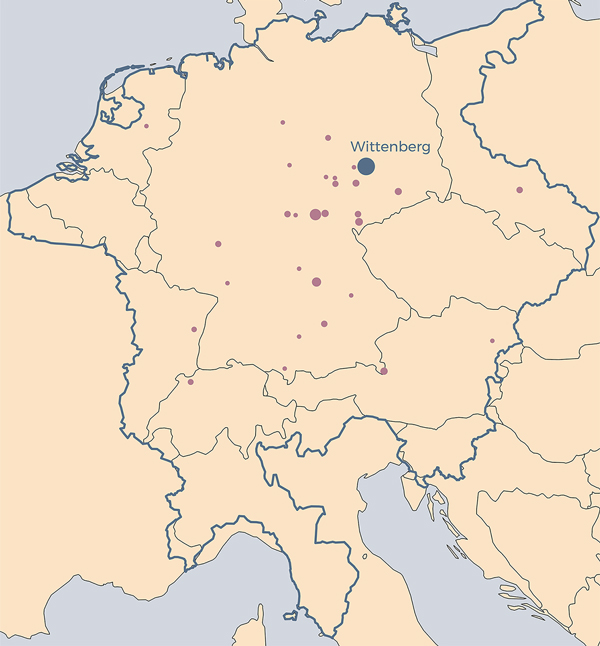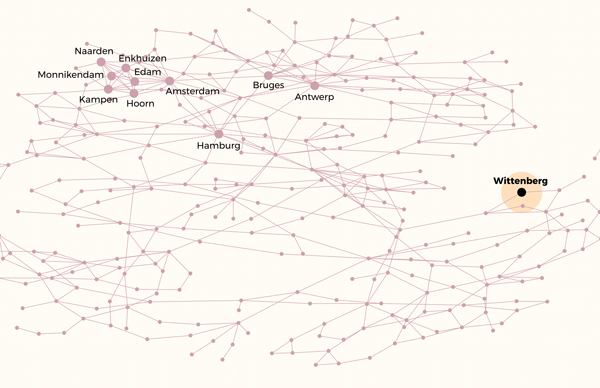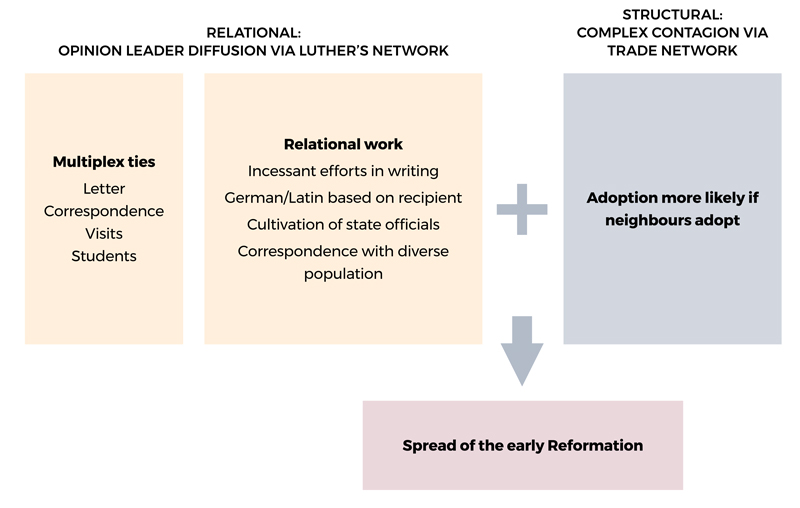by Sascha O. Becker and Jared Rubin
Networks are everywhere. Of course, today we are used to social networks, where information and ideas can spread at an extremely rapid rate. If someone sends a meme to two friends, and they send that meme to two friends, and so on, the idea gets to thousands of people (or more) with little effort. Social scientists call these ‘network effects’. But how did networks operate before the rise of social media? We recreate the networks of Martin Luther, a key influencer of the 16th century, to find out the role they played in the spread of the Protestant Reformation.
The Protestant Reformation in the 16th century was a classic situation in which networks might have really mattered. Initially, adopting the Reformation was costly: the Catholic Church denounced Protestant ideology as heresy, Protestants were burned alive and religious warfare was endemic. When adoption is costly, knowing that your neighbours adopted is useful – at least you will have allies. Networks also help facilitate the spread of information, which is incredibly important for a movement steeped in ideology.
Recreating Martin Luther’s network
It is hard to recreate personal networks as we need a lot of information about the person in question. Who did they know? How well did they know them? Where were their contacts located? This information is hard enough to get for people in the contemporary world (unless you work for Facebook): it is next to impossible for most historical figures.
Fortunately, Martin Luther (1483–1546), the leader of the Protestant Reformation, left enough traces where it ispossible to recreate his network. There has been much work done by a panoply of historians documenting numerous aspects of Luther’s life. Many of the letters he wrote survived and have recently been digitised. For the sake of reconstructing Luther’s spatial network, we coded every city in which Luther sent a letter (fig.1).
Figure 1: Luther's spatial network. Cities to which Luther sent a letter 1502–22

Due to the meticulous work of Georg Buchwald, we know each city that Luther visited and when he visited it. From the work of Hyojoung Kim and Steven Pfaff, we know the location of each of Luther’s students at the University of Wittenberg. While this data of course does not tell us every person Luther ever met, it does give us a pretty good indication of whom he had some influence with.
The role of Luther’s networks in the spread of the Reformation
Luther was influential. He played the role of a global opinion leader based in Wittenberg. He had ties with local elites in towns across Central Europe, who in turn exerted influence in their towns. We can conceive of the process as leader-to-follower, originating with Luther and flowing to local elites through personal ties. Who Luther was connected to may therefore have mattered to the success of the Reformation.
But the Reformation may have also spread independently of Luther. Because it was costly to adopt, towns were only likely to adopt if they were connected to another town, via a network, that also adopted. We could therefore envision the Reformation as a ‘virus’ that spread out of Wittenberg.
So, which was it? Was Luther completely unimportant to the spread of the early Reformation? Would any ‘heretical’ movement coming out of Wittenberg have lit the anti-papal fuse, even in the absence of Luther? This is unlikely. As we show in Figure 2, Wittenberg was not very well connected within the Holy Roman Empire (via trade routes). It was, in Luther’s words, ‘on the edge of civilisation’. So the trade network was probably not enough to spread the Reformation.
Figure 2: The Holy Roman Empire trade network
The Holy Roman Empire trade network, mapped by linkages. Wittenberg, on the relative outskirts of the network, is circled in purple.

But was Luther’s network enough, on its own, to account for the spread of the Reformation? Here, our analysis also finds little evidence in favour. We conduct a simulation analysis and show that Luther would have had to have been improbably ‘infectious’ for his network to fully explain the spread of the Reformation. In other words, way too many nodes in Luther’s network would have had to adopt the Reformation because of Luther (and not a myriad of other causes contributing to the success of the Reformation) for this to be the dominant explanation.
So, did Luther’s network matter at all? In short, yes. We argue – and our simulations and regression analyses support – that personal/relational diffusion via Luther’s network combined with spatial/structural diffusion via trade routes helped Protestantism’s early breakthrough from a regional reform movement to a widespread rebellion against the Roman Catholic Church.
Figure 3 illustrates this idea. Multiplex ties point to how Luther as an opinion leader mobilised his personal network through an ensemble of letters, visits, and student relationships. It also shows how Luther’s network blends with the spatial (trade) network to create complex ‘contagion’ processes operating at the intersection of information flow and social influence.
Figure 3: The role of networks in the spread of the Protestant Reformation

Our findings show that multiple diffusion mechanisms can reinforce each other to facilitate the spread of ideas within a network, even if each mechanism by itself is not sufficient. This not only provides new insight for the spread of the Protestant Reformation, but also has interesting implications for the understanding of how ideas spread and gain influence today.
About the authors
Sascha O. Becker is Xiaokai Yang Chair of Business and Economics at Monash University, Melbourne, part-time Professor at the University of Warwick, and a CAGE Associate.
Jared Rubin is a Professor of Economics at Chapman University.
Publication details
The article is based on the paper Becker, S O., Hsiao, Y., Pfaff, S. and Rubin, J. (2020). Multiplex Network Ties and the Spatial Diffusion of Radical Innovations: Martin Luther's Leadership in the Early Reformation. American Sociological Review, 85(5): 857–894 (Open Access).
